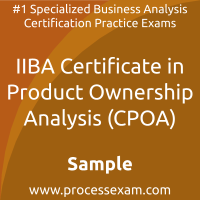 You have to pass the CPOA exam to receive the certification from IIBA. To increase the effectiveness of your study and make you familiar with the actual exam pattern, we have prepared this IIBA Product Ownership Analysis sample questions. Our Sample IIBA Certificate in Product Ownership Analysis Practice Exam will give you more insight about both the type and the difficulty level of the questions on the IIBA Product Ownership Analysis exam.
You have to pass the CPOA exam to receive the certification from IIBA. To increase the effectiveness of your study and make you familiar with the actual exam pattern, we have prepared this IIBA Product Ownership Analysis sample questions. Our Sample IIBA Certificate in Product Ownership Analysis Practice Exam will give you more insight about both the type and the difficulty level of the questions on the IIBA Product Ownership Analysis exam.
However, we are strongly recommending practice with our Premium IIBA Certificate in Product Ownership Analysis (CPOA) Practice Exam to achieve the best score in your actual IIBA CPOA Exam. The premium practice exam questions are more comprehensive, exam oriented, scenario-based and exact match of IIBA Certificate in Product Ownership Analysis exam questions.
IIBA Product Ownership Analysis Sample Questions:
01. Which artefact serves as a blueprint for implementing the product strategy and describing the financial feasibility of the product being built?
a) Release plan
b) Iteration plan
c) Business model canvas
d) Product roadmap
02. As part of the outcomes of product ownership analysis (POA), it is crucial to create a shared understanding of which deliverable?
a) Solution option for build
b) Strategic product vision
c) Product backlog
d) Solution option for design
03. From which perspective should the product ownership analysis (POA) practitioner assess a change?
a) Strategy perspective
b) Delivery process perspective
c) Risk perspective
d) Value perspective
04. Utilizing technology to improve the team's efficiency:
a) creates a faster turnaround.
b) allows for better measurement of the product's value.
c) creates a barrier between the product owner and the team.
d) allows for better prioritization of features.
05. A product ownership analysis (POA) practitioner uses experimentation in order to design a better:
a) test case.
b) feature.
c) schedule.
d) product backlog.
06. Which technique would a product ownership analysis (POA) practitioner use to understand which product characteristics or qualities will prove to be a significant differentiator in the marketplace?
a) Balanced scorecard
b) Value stream mapping
c) Kano analysis
d) Metrics and key performance indicators
07. When creating a supportive environment for Product Owners and product teams, organizations should pay attention to?
a) Hours of work
b) Payroll processes
c) Products and services aligned to strategy
d) Time spent in office
08. In which planning horizon does a product ownership analysis (POA) practitioner create product vision in collaboration with stakeholders?
a) Initiative level
b) Strategy level
c) Delivery level
d) Planning level
09. At the end of the structured iteration planning session, the team affirms a shared commitment to the iteration goal that is:
a) clearly understood, compelling, measurable.
b) common, projectable, commendable.
c) clear enough, trackable, acceptable.
d) traceable, well understood, agreeable.
10. How should stakeholder analysis be assessed as the work progresses?
a) Ad hoc
b) Retrospectively
c) Sequentially
d) Continually
Answers:
Question: 01
Answer: c |
Question: 02
Answer: b |
Question: 03
Answer: d |
Question: 04
Answer: a |
Question: 05
Answer: b |
Question: 06
Answer: c |
Question: 07
Answer: c |
Question: 08
Answer: a |
Question: 09
Answer: a |
Question: 10
Answer: d |
If you find any errors or typos in IIBA Certificate in Product Ownership Analysis (CPOA) sample question-answers or online IIBA Product Ownership Analysis practice exam, please report them to us on feedback@processexam.com
 You have to pass the CPOA exam to receive the certification from IIBA. To increase the effectiveness of your study and make you familiar with the actual exam pattern, we have prepared this IIBA Product Ownership Analysis sample questions. Our Sample IIBA Certificate in Product Ownership Analysis Practice Exam will give you more insight about both the type and the difficulty level of the questions on the IIBA Product Ownership Analysis exam.
You have to pass the CPOA exam to receive the certification from IIBA. To increase the effectiveness of your study and make you familiar with the actual exam pattern, we have prepared this IIBA Product Ownership Analysis sample questions. Our Sample IIBA Certificate in Product Ownership Analysis Practice Exam will give you more insight about both the type and the difficulty level of the questions on the IIBA Product Ownership Analysis exam.